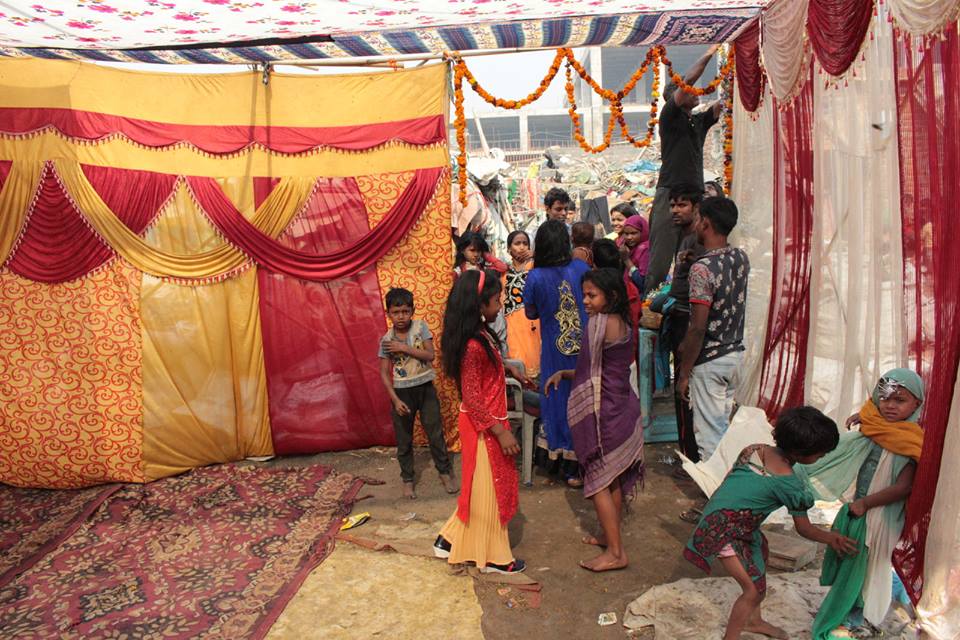December 2016
THE FACE OF THE CITY THAT WE IGNORE –
Visiting Delhi as a tourist is all about relishing the ancient glory of the capital encapsulated by the contemporary style of art and architecture. But visiting Delhi as environmental enthusiasts, a bunch of us from Friend In Need India, decided to ditch the beautiful face of the city and dared to seek out the ugly face that everyone ignores. This was part of a discovery tour organized by Friend In Need prior to our conference on World Toilet Day, November 19, for village Panchayats and our conference speakers.
PART 1: THE PATHETIC STATE OF THE LANDFILLS
Ever wondered where most of the garbage we ignorantly dump, land in? Most of us might not. We consider getting  rid of the garbage from our household as the end of our role. But, little do we realize that the unsegregated waste we throw, marks the start of a catastrophe which will terribly bite us back in the form of toxic pollution!
rid of the garbage from our household as the end of our role. But, little do we realize that the unsegregated waste we throw, marks the start of a catastrophe which will terribly bite us back in the form of toxic pollution!
Our visit to the Ghazipur landfill hit us hard with reality. Imagine garbage being piled up for more than 50 meters over a spread of 70 acres of land. That’s Ghazipur landfill for you! The tonnes of waste that Delhi generates gets dumped here daily as a new layer upon the existing one, increasing the risk at an alarming rate. The waste that is generated in the various parts of the city are collected in trucks through private contractors, who are paid on a per-truck basis.
 This landfill can be aptly described as a flaming mountain of composting waste, smoking methane, which adds to Delhi’s air pollution woes. The worst part is that there are three more such landfills in Delhi that are even bigger than this. This landfill attracts thousands of scavenging birds that can be seen circling the huge masses of garbage. In addition to the birds, animals like dogs marching here to feed themselves are a common sight. The leachate that percolates and oozes out of these landfills make things worse by filling the air with a foul smell. This smell can penetrate to even places as far as 2 kilometres from the landfill during the summer. This clearly reflects the poor waste management system in our country.
This landfill can be aptly described as a flaming mountain of composting waste, smoking methane, which adds to Delhi’s air pollution woes. The worst part is that there are three more such landfills in Delhi that are even bigger than this. This landfill attracts thousands of scavenging birds that can be seen circling the huge masses of garbage. In addition to the birds, animals like dogs marching here to feed themselves are a common sight. The leachate that percolates and oozes out of these landfills make things worse by filling the air with a foul smell. This smell can penetrate to even places as far as 2 kilometres from the landfill during the summer. This clearly reflects the poor waste management system in our country.
Mr. Shashi, the General Secretary of All India Kabbadi Mazdoor Mahasangh believes that only 10-15% of the waste  will reach the landfills, if they’re properly segregated at source and recycled. He also lays strong emphasis on the fact that waste is a wonderful resource and by letting them to burn, people are losing their livelihood. It’s high time we start realizing the importance of segregation and waste management to gift ourselves a wonderful pollution-free future.
will reach the landfills, if they’re properly segregated at source and recycled. He also lays strong emphasis on the fact that waste is a wonderful resource and by letting them to burn, people are losing their livelihood. It’s high time we start realizing the importance of segregation and waste management to gift ourselves a wonderful pollution-free future.
THE FACE OF THE CITY THAT WE IGNORE – PART 2: UNINHABITABLE CONDITIONS WITH SMALL DREAMS
Imagine a fuming mountain of garbage ejecting pungent smell located next to your house. Sounds disgusting? That’s exactly the conditions the waste pickers live in near the landfills. Our visit to the ‘mini town’ of the waste pickers near the Ghazipur landfill turned out to be very depressing.
The people who reside here solely depend on collecting waste for their livelihood. This locality that houses 400-500 waste collectors has everything inside it – right from small shops to basic medical dispensary. But poor dilapidated homes with thatched roofs didn’t seem to affect the liveliness of the locality. Or should we say they are forced to accept this lifestyle? Or are they just used to it? The people were busy with the everyday chores just like any other place, yet actively interacted with us.
 Small kids play around the garbage without knowing the harmful effects of the toxic waste lying right behind them. A wedding was about to happen on the very day and a small make-shift marriage hall was being prepared by enclosing a small open space with curtains. There was great excitement and joy with preparations in full swing. A few young girls were cheerfully making the bride look beautiful with henna, while a bunch of other men were cooking food in huge containers for serving the guests. All these against the backdrop of a mountain of garbage and just a few meters away from it!
Small kids play around the garbage without knowing the harmful effects of the toxic waste lying right behind them. A wedding was about to happen on the very day and a small make-shift marriage hall was being prepared by enclosing a small open space with curtains. There was great excitement and joy with preparations in full swing. A few young girls were cheerfully making the bride look beautiful with henna, while a bunch of other men were cooking food in huge containers for serving the guests. All these against the backdrop of a mountain of garbage and just a few meters away from it!
The rag pickers are unofficial workers who climb the mountain of garbage every day in search of recyclables. They segregate and sell them for a living. It was disturbing to see small kids involved in the waste collection from these landfills along with men and women. They are involved in this without a clue about the hazardous toxic substances they’re exposed to. Without any protective garments or equipment, they’re often affected by respiratory issues.

No one seems to be concerned about the pathetic living conditions that these rag pickers are exposed to. The people here are stuck in a small sphere of life in the garbage with small dreams. Unless some drastic measures are taken to change the waste management system, this exploitation and inhuman conditions won’t cease to exist. We have to be also a part of this change. This will not happen unless we demand it and participate in the change by starting ourselves to segregate waste in our homes, schools and offices.
Post by FIN Volunteer: Shanmugarajan
Photos by: Sueli Kyomi Brodin, UNU-MERIT


